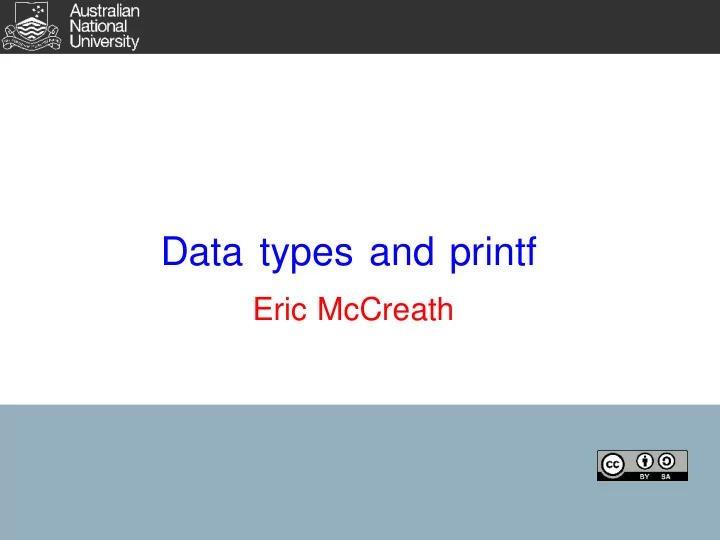

Data types and printf Eric McCreath
Learning c It is difficult to order how this material on c programming is presented such that content purely builds on previous content. Thus we just 'jump into' the c programming language and then focus on different aspects. Also, as I assume people have some programming background, I will move through this material very quickly. These notes give an outline of what we are looking at. They are not intended be be a complete reference on the c programming language. "Practical C Programming" by Oualline is a good reference, however, there is a lot of other sources of reference for this material. 2
Not many basic data types There is not many basic data types in c. The basic data type you mainly use in c include: integer - which stores whole numbers (numbers without a decimal point). These include: int, char, short, long, .. floating point numbers - these store a large range of fractional numbers (from the very small to the very large). void - this can be thought of as an empty data type or as any data type. As if you do not know the type of a variable you can refer to it as type 'void'. Other higher level languages often have strings and booleans as part of the language. c doesn't! 3
Integer Integers include numbers like 5, 1000, -30, 0, .... They are represented using 2s-complement and have a fixed range. The range will depend on the architecture (this creates all sorts of problems when moving code between different architectures). On most desktop systems we use integers are 32 bit. To declare an interger you just use the 'int' keyword. e.g. int value; 4
Integer c also lets you use a range of different integers. These include: char - a single byte unsigned char - understood as a number that ranges from 0 to 255, rather than -128 to 127. short - normally 16 bits unsigned short int - normally 32 bit unsigned int long unsigned long long long unsigned long long 5
printf To use printf you need to remember to include: #include<stdio.h> printf has the a format string followed by an optional number of expressions: printf(<fomat>, <expression1>, <expression2>, ...); So remember: printf("Hello World!�"); Your use %d for integers. e.g. int value = 70; printf("v: %d twov: %d justfive: %d�", value, 2*value, 5); // prints "v: 70 twov: 140 justfive: 5" Use "man 3 printf" to get more info on the formatting used by printf. 6
floating-point float - 32bit precision float double - 64bit precision float Literals can be given using a decimal point. e.g. float value1 = 3.14; Also literals can be given using an exponent form. e.g. float value2 = 1.5E3; float value3 = -1.6E-6; float value4 = 100e4; %f can be used within printfs. e.g. printf("val: %f", value1); %e can be used to display using the exponent style. Remember with floats your precision is limited by how the number is represented. Although errors can be small they often can accumulate! 7
booleans and flags A integer type is used for representing booleans. So 0 is false and anything non-zero is true. Two common traps for new players: if (x = 100) { .... and #define TRUE 1 #define FALSE 0 : if (x == TRUE) { ... Particular bits within an integer can be used to represent different flags. #define FLAG1 0x01 #define FLAG2 0x02 #define FLAG3 0x04 : flag = flag | FLAG2 // set FLAG2 flag = flag & ~FLAG2 // clearing FLAG2 if (flag && FLAG2) // checking a flag 8
Pointers/fixed point Points are also a basic data type in c. They basically point to locations in memory. Generally fixed point representation are not supported in c. Although, gcc has some support fixed point numbers. More about pointers in latter lectures. 9
Exercises Read the man page for printf (man 3 printf). Write a program that outputs both integer and floating point numbers. Explore how printf can be used to justify printed numbers so a lined up column of numbers can be output. Also get floating point numbers to be printed with a fixed number of decimal places shown. 10
Recommend
More recommend